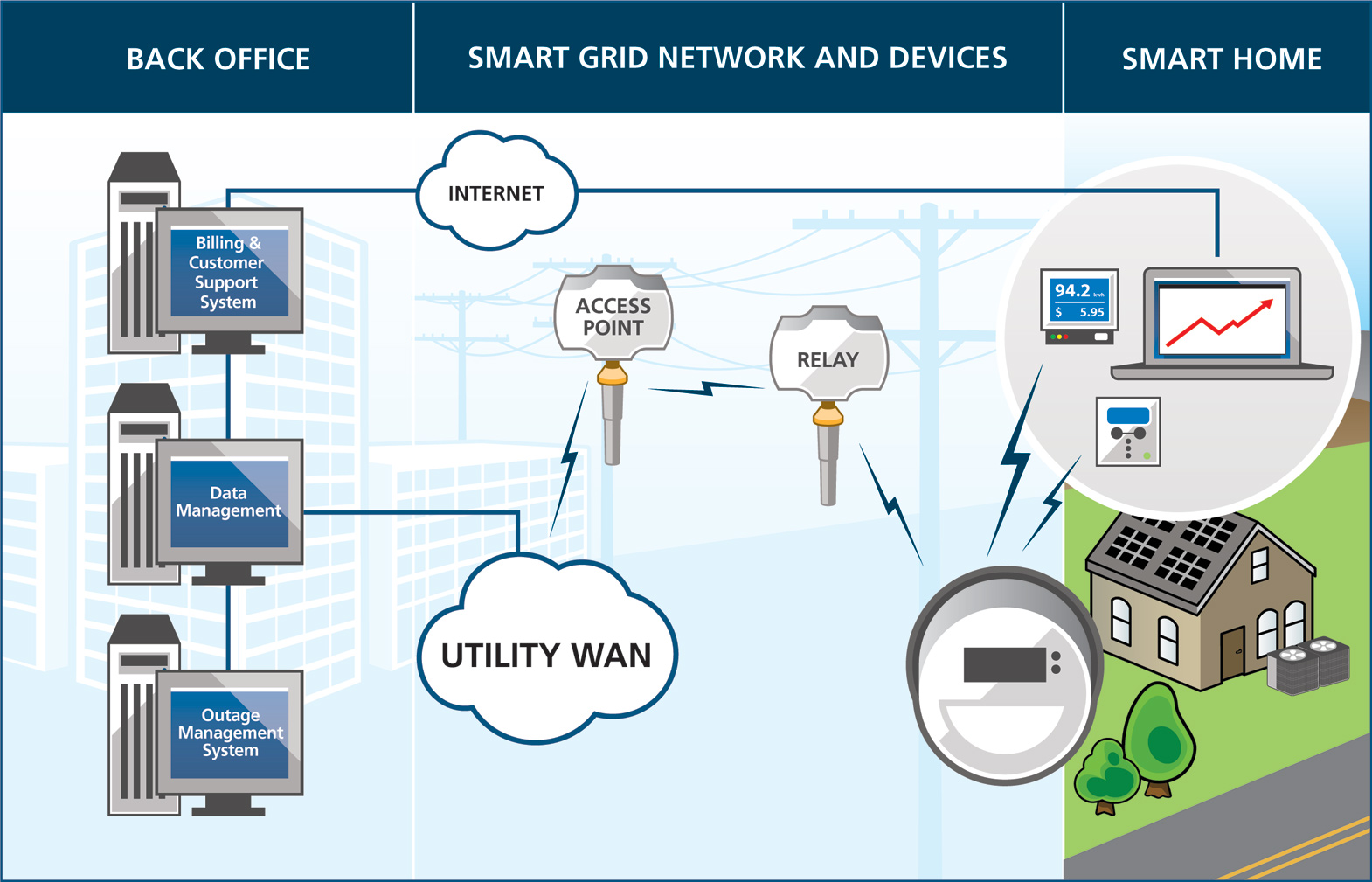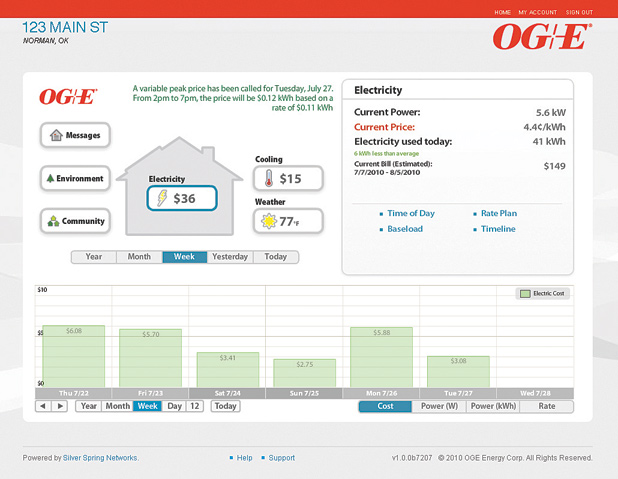The ultimate success of a Smart Grid in achieving greater energy efficiency relies on the strength of the partnership between a utility, its customers and its regulators. Although surveys show that the public has positive feelings about Smart Grid technology and is eager to use it, successful implementation requires a comprehensive communications strategy. Without strong customer education and support, the benefits of smart meters and other smart-energy tools, such as energy management websites, in-home displays (IHDs) and programmable communicating thermostats (PCTs) will not be realized. Recognizing this, Oklahoma Gas & Electric (OG&E) designed a study and communications plan to learn more about how customers could and would use new Smart Grid tools.
A Study is Born
In March 2010, the utility began Smart Study TOGETHER™, an effort funded by part of a $130 million grant from the U.S. Department of Energy and endorsed by the Oklahoma Corporation Commission in July 2010 when it approved a $240 million rider on customers’ bills for system-wide smart grid deployment. Some 3,000 volunteer households and businesses in Norman, Okla., were recruited to join in the study, which ran from June 2010 through September 2010 and will run again during the same four months in 2011.
.jpg)
Two in-home devices used as part of OG&E’s Smart Study TOGETHER™ in Norman, Okla.
Residential participants are assigned one of two dynamic price plans and one, two or all three of the in-home tools enabling them to monitor their energy use – the PCT, IHD and energy management website. Business participants have their choice of price plans and technology. The goal of the study is to determine, with statistical validity, if OG&E in partnership with its customers can reduce system-wide peak demand by approximately 160mW.
Ultimately, by seeing how customers react to having more information about the cost and their use of energy, OG&E will be able to learn what combination of pricing plans, technology and customer messaging will result in the most significant behavioral changes. Smart Study TOGETHER aims to provide a template for OG&E – as well as the DOE and other utilities – to consult when planning future applications for Smart Grid technologies and pricing plans.
Focus on the Customer
From the start, OG&E’s focus has been on the customer. The company continues to proactively communicate with customers to clearly describe the benefits of the comprehensive deployment of Smart Grid using paid mass media, letters mailed to homes and businesses, door hangers and fliers distributed by field personnel, and information available online. The same tactics along with e-mail and face-to-face “sales calls” were used to recruit study participants last spring.
To complement this effort, meter techs, field service representatives and call-center employees receive special training to help them answer customer questions. OG&E representatives attend community meetings to explain the benefits of the program and also meet with local leaders to gain their support and understanding of the benefits to the community. OG&E continues to assure customers that while the new Smart Grid technology can empower them to control their energy use and lower their bills; it does not provide the utility direct control of customers’ devices. Customers control and predetermine their price and comfort sensitivity. To monitor awareness of the Smart Grid and brand reputation, the company conducts quarterly telephone surveys.
Finally, OG&E ensures that its customers and employees understand the importance of participation in the study. Several customers have provided testimonials about why they want to be part of the study. (See sidebar featuring Steve Kaplan, owner of Native Roots Market in Norman.)
Building on Success
Smart Study TOGETHER builds on the positive results of a smaller, three-month study that OG&E conducted in the summer of 2008 with 25 residential customers in Oklahoma City. At the conclusion of that pilot, a survey of the participants found that 100 percent were more aware of their energy consumption and pricing. This knowledge enabled the participants to cut their energy use during peak hours of 2 p.m. to 7 p.m., with the households saving an average of 10 percent to 13 percent per month on their energy bills during the summer months.
OG&E also realized operational savings from smart meters and the rest of the advanced metering infrastructure installed in the same area to serve 6,600 customers. This data helped drive OG&E’s decision to pursue a comprehensive integrated Smart Grid deployment – including advances in demand response, wind energy and regional transmission – to reduce peak demand enough to avoid building new fossil fuel capacity before 2020.
Pricing Plans
For the study, OG&E is testing two innovative pricing plans to determine which is best suited to which customer groups. One is a standard Time-of-Use (TOU) plan, and the other option is Variable Peak Pricing (VPP). Both plans include a Critical Price (CP) overcall component. Under TOU, customers pay a higher price for energy used during the peak demand period of 2 p.m. to 7 p.m. weekdays. VPP offers four peak period prices.
.jpg)
A PCT displays the peak price
for a customer in OG&E’s
Smart Study TOGETHER™ Program
The peak price for a day is set by 5 p.m. the evening before. These prices are communicated to participants in the study through one or all of the methods of their choosing, including automated phone calls, e-mail, and cellular text messages. The day-ahead prices also are posted each day on the corporate website www.oge.com/price by 5 p.m. and in the future will be available via an Apple iPhone application from OG&E. The peak prices also are communicated via sophisticated back-end software to study participants via their IHDs, PCTs and the myOGEpower.com website.
These smart tools also display a highly accurate estimate per kWh, including taxes and other charges, so study par-ticipants receive the most actionable information possible to make choices about their energy consumption each day. Similarly calculated month-to-date cost estimates are also available on the IHDs and web portal.
Smart Energy Platform
The Smart Energy Platform (supplied by OG&E partner Silver Spring Networks) enables the demand response capabilities. This Smart Energy Platform includes an AMI network, the communications module in OG&E’s Smart Meters, back-end demand management software, the secure energy management website, and in-home devices such as PCTs and IHDs. The tools provide customer-friendly views and management.

Diagram depicts 2-way communication between the Home Area Network (HAN) and the Wide Area Network (WAN).
Electricity usage data is collected at the meter and then distributed to in-home devices within the HAN.
At the same time the data is sent out via access points to OG&E’s back office via the WAN.
That information is then routed back to the consumer via the internet and viewed using myOGEpower.com.
The thermostats, for example, feature a simple interface for efficiently using air conditioning during off-peak hours, critical since 35 percent of power in Oklahoma is used for central air. The thermostats offer customers five separate settings that allow them to easily balance comfort and economy in their homes or businesses, taking into account time of day and kWh price. For example, participants can choose programs that “pre-cool” their homes before peak demand times, turn up or off the air conditioning when they are away for longer periods of time, and turn down their air conditioning temperature just before they arrive home from work.
Energy Information Access
The IHD is a small, wireless device about the size of a cell phone that can be carried around or magnetically affixed to a refrigerator or file cabinet. It provides valuable information on energy pricing and use. Using its six buttons, users can easily scroll through the device’s screens to find data on current electricity use, in dollars, cents and kilowatt hours; daily, weekly and monthly usage; and the current price of energy. Even more energy use and cost information is available when study participants log-on to their own personalized websites at myOGEpower.com.
On the web, customers find their energy consumption and cost information, as well as being able to compare their usage to that of others in their community and see details about their carbon footprint. Each customer’s energy consumption is presented in detailed graphs, showing usage by time and price. This data allows customers to see how their energy prices fluctuate depending on the weather and time of day, allowing them to make choices based on more information.
Throughout the study, OG&E is checking back with participants to gather intelligence about how they receive the most value from Smart Grid applications and about how to best engage customers in programs to capitalize on the promise of Smart Grid technology.

OG&E’s myOGEpower.com website enables customers participating in the study to
view electricity pricing and their consumption information in near real-time.
A Customer’s Experience
As the owner of the Native Roots Market in Norman, Oklahoma, Steve Kaplan specializes in offering his customers organic, locally grown and high-quality fresh foods. Since opening the store three years ago, Kaplan also has tried to conserve as much energy as possible, taking steps such as installing energy-efficient lighting, motion-activated lights in his stockroom, and ceiling fans to reduce the energy draw for air conditioning. So Kaplan was intrigued when he saw an insert with his regular OG&E bill promoting a chance for businesses to join a study seeking ways to cut energy use. He signed up online, and his store was soon fitted with new programmable communicating thermostats, as well as a wirelessly connected smart meter. Kaplan also gained access to a personalized website detailing his store’s energy use and daily e-mails from OG&E relaying energy prices for the next day’s peak period of 2 p.m. to 7 p.m.
Armed with this information, Kaplan began to make some small adjustments that have resulted in significantly curtailing his store’s energy consumption. He stocks a refrigerator of grab-and-go drinks early in the morning, so that the doors aren’t opened as frequently during peak-hour energy prices. He also pre-chills the store to 73 degrees in the morning and then cuts off the air conditioning for an hour or two when the 2 p.m. peak price period begins. In addition, Kaplan regularly checks the OG&E website to review his store’s energy consumption. The changes are modest, but the results are astounding. “When our first bill came, we were shocked at the savings that they reported. We just couldn’t believe them,” he says. “The bill would normally have been approximately $1200, and it was $700.”
That $500 in savings sold Kaplan on the new technology. “Now that we have the in-home device and the thermostats, we look at it every day to see what our usage is and what we can possibly do to conserve during the peak period,” he says. “I expected that we would save something, but I didn’t think there were that many things we could do at our store to affect the bill because of the nature of our operation. So we’re just delighted with what’s happened.”
PROGRAM FACTS: Smart Study TOGETHER™
Launched: March 2010
Study Size: 3,000 volunteer households and businesses in Norman, Oklahoma
Timeline: June 2010 through September 2010; will run again during the same four months in 2011
About the Study: Residential participants assigned one of two dynamic price plans and one, two or all three of the PCT, IHD and web tool to monitor energy use; Business participants have their choice of price plans and technology.
Goal: To determine if, through a statistically valid trial, OG&E in partnership with its customers can reduce system wide peak demand by approximately 160mW
Funding: Part of $130 million grant from the U.S. Department of Energy
Technology Partner: Silver Spring Networks
About the Authors

Ken Grant is Managing Director of Positive Energy® Smart Grid Programs at OG&E. His education includes a BS from the University of Oklahoma and an MBA from the University of Central Oklahoma. Ken has worked for OGE for 18 years. In his current role he directs a team of professionals tasked with understanding all aspects of smart grid technologies and the potential implications on OG&E and its customers. The team completed deployment of the first Positive Energy® Community in Norman, Oklahoma in May 2010, and is continuing deployment across the remainder of OG&E’s service territory.

Matthew Smith heads up Silver Spring’s product marketing team for the energy efficiency, demand response and electric vehicle charging solutions. Matthew has over 20 years of startup business experience in the energy management, home computer, consumer electronics, and Internet industries. Prior to Silver Spring, Matthew was in charge of marketing and sales for Greenbox Technology, an early leader in customer facing, smart grid applications. Matthew holds an MBA in Sustainable Management from the Presidio School of Management and a B.S. in Computer Science from the University of Pittsburgh.







